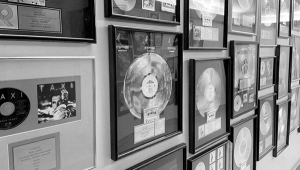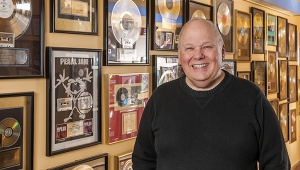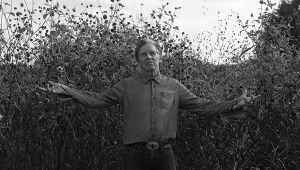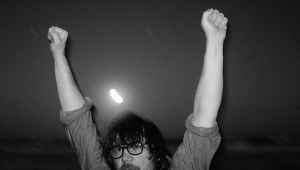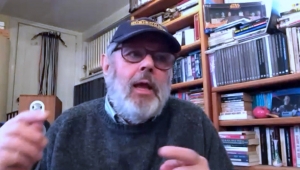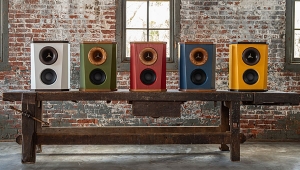| Columns Retired Columns & Blogs |
Hiroyasu Kondo: Audio Notes
Our interview with Hiroyasu Kondo—founder of Audio Note Japan, and a legendary figure in his own time—took place during HI-FI '96 last June at the Waldorf=Astoria. It seemed very natural; the crowd at the Show was very internationalist. Herb Reichert of Audio Note New York found us a quiet corner after lunch, and we sat down to talk.
 This was a group affair. I sat with Kondo-San on my left, and Masahiro Shibazaki directly across from me. A very obedient (you'll see what I mean) Masaki Ashizawa of Audio Note sat on my right, while my wife Kathleen and Herb filled out the table. Shibazaki-San, President of Sibatech—he imports Lowther single-driver speaker units and other UK audio gear—served as the interpreter (Kondo does not speak English). Nor is Shibazaki a disinterested party—it was he, after all, who named the Ongaku amplifier.
This was a group affair. I sat with Kondo-San on my left, and Masahiro Shibazaki directly across from me. A very obedient (you'll see what I mean) Masaki Ashizawa of Audio Note sat on my right, while my wife Kathleen and Herb filled out the table. Shibazaki-San, President of Sibatech—he imports Lowther single-driver speaker units and other UK audio gear—served as the interpreter (Kondo does not speak English). Nor is Shibazaki a disinterested party—it was he, after all, who named the Ongaku amplifier.
As you read the interview, understand that I addressed my questions directly to Kondo, but as well to Shibazaki, as it was his onerous task to translate my pithy and probing questions (to which task he applied himself masterfully). I have not included as part of the flow of the interview the occasionally long process of asking of a (sometimes prickly) question and its translation into Japanese, and then the response and its translation into English.
I propped my low-ball Sony mike facing Shibazaki, rolled tape, and asked Kondo-San how he had gotten involved in audio....
Masahiro Shibazaki: He says he was born the son of a priest in a Buddhist temple, where he often heard his father and other priests chanting. It's a very beautiful acoustical sound, the priest chanting from deep inside his body.
Jonathan Scull: And how did that translate into a pursuit of audio excellence?
Shibazaki: Well, his musical tastes changed to opera, which, of course, very much resembles chanting...
Scull: Opera and Buddhist chanting—an unusual musical link I never made before...
Shibazaki: As a priest, his father was very famous, but he was also known for making things by himself, like amplifiers. And Kondo-San was very influenced by his father.
He was also strongly influenced by a performance he heard at 16 years of age. It was the fourth movement of the "New World" Symphony, conducted by Toscanini...in 1953. He says it was to this golden age of recording that he listened when he was young.
Scull: What was the defining moment when you decided to begin to manufacture your own equipment?
Shibazaki: Well, specifically there was no particular moment. It happened over a period of time. Chronologically it was when he resigned from CBS/Sony in 1976. That was a very big company where he felt he couldn't achieve his dream of building a better sound system.
Scull: What were you doing for Sony, Kondo-San?
Shibazaki: He started as a recording engineer, and later was involved in the improvement of the machines they were recording on.
Scull: What was it about Sony's philosophy that disturbed him? And in what way does that differ from his own philosophy?
Shibazaki: Kondo-San says that is a difficult question. [laughs]
Scull: Thank you! [laughter]
[Kondo-San spends some time talking to Shibazaki.]
Shibazaki: Okay...well, it's difficult to translate, but in Japan, the social background is somewhat unique. Outstanding achievements by an individual may sometimes be beaten down by others, especially big manufacturers such as CBS/Sony. They were building components for mass-market consumers. Kondo says that in this way you get a very average sound that does not reflect the individual character of the designer.
Scull: Is this perhaps due to the group culture of Japan?
Shibazaki: He says yes, it's in the Japanese culture historically. In fact, his friends were mostly lone wolves like himself, operating their own companies.
Scull: But I interrupted. You were explaining about the philosophical differences...
Shibazaki: Simply put, he says he was trying to develop the sound that he was dreaming of.
Scull: And that wasn't going to happen at CBS/Sony!
Shibazaki: That's why he...spun out, I think you say?
Scull: Close enough. Now, as I understand it, Audio Note makes almost every component used in the equipment, so let me ask about the philosophy behind that.
Shibazaki: It's very simple.
Scull: That's good! [laughter]
Shibazaki: He just hated using components made by others, because those manufacturers were giving priority to mass production. What he wanted to do was achieve that special sound of his dreams. In other words, he put the priority on the sound, not on efficiency of production.
This naturally led him to make his own components—like capacitors, for instance. Eventually he was able to make almost everything himself—transformers, cables and wires. What he does not do are resistors. [laughs ruefully] He has to buy resistors from others. But he wants to say he wishes to develop his own resistor in the near future!
Scull: How did you arrive at single-ended circuit topologies? Did you begin with push-pull designs?
Shibazaki: Yes. Actually, the first design was a push-pull amplifier using 211 tubes.
Scull: What caused the transformation to single-ended?
Shibazaki: Well, single-ended amplification was long known to Japanese audiophiles. One day he thought of changing his design to single-ended, as he was much attracted by the purity or...[speaks with Kondo]...or the obedience of the sound, you could say. [laughs]
Scull: "Obedient" sound...I'd like to understand that a bit more.
Shibazaki: It means transparency. For example, even driven by a very small level of signal, Audio Note equipment keeps its clarity and transparency. That's the first way to explain it.
Scull: Are we talking digital or analog?
Shibazaki: Well, he says the biggest merit of analog audio technology is that clarity or linearity at a small level of signal. Which digital technology cannot replace, even today. [Kondo speaks for a few moments.] He says when you listen to a string instrument that's hit by a hammer wrapped with a felt cushion, for example, that it can "obediently" be replayed by analog, but not by digital. The sound of felt-wrapped hammers...you can almost feel the string sound, and touch it. The sound is very, very delicate.
[Kondo speaks for quite some time to Shibazaki.]
He says that when the same instrument is played through digital components, it may be felt by listeners to sound as though the string was struck by an iron hammer. And that's the reason single-ended is better, because it can express these very delicate differences in sound.
Scull: Does Kondo-San recognize any problems or drawbacks with single-ended reproduction?
Shibazaki: Just its low output power. That's the only demerit.
Scull: Since push-pull cancels out even-order harmonics and single-ended leaves all harmonic distortion intact—both even- and odd-order—does he think that has anything to do with it? How would he describe the difference in sound between push-pull and single-ended?
- Log in or register to post comments

